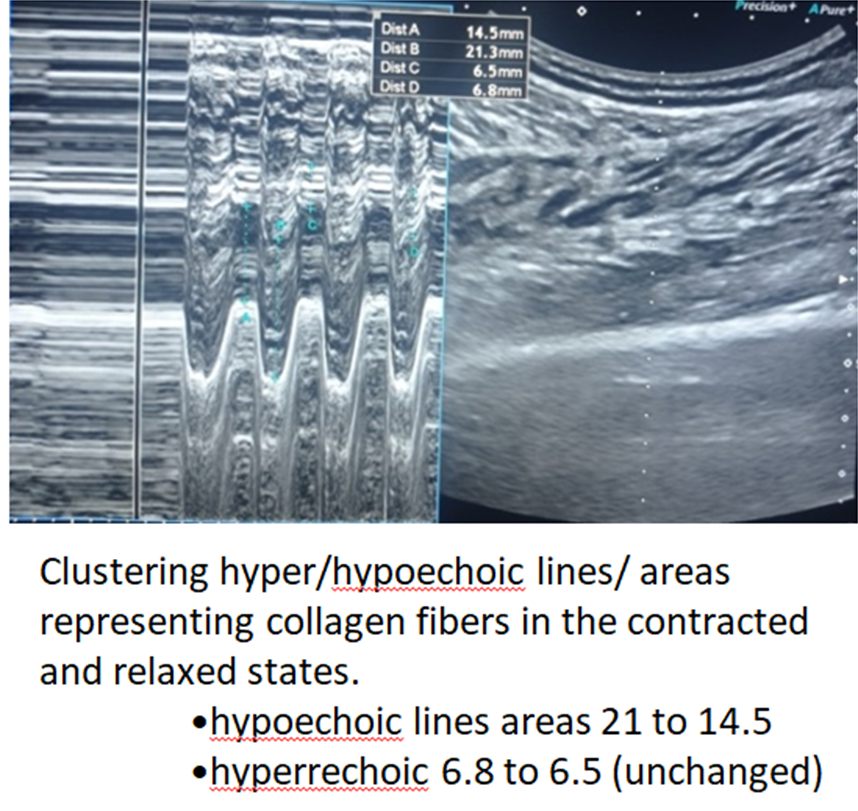Category: Spasticity
Objective: The objective of this study was to evaluate the feasibility and reliability of ultrasound imaging as a method to estimate collagen content in contracted and non-contracted muscle areas.
Background: Oversupply and underutilization of lipid fuels are widely recognized to be strongly associated with insulin resistance in skeletal muscle. The primary focus of this study design is to assess the feasibility and reliability of ultrasound imaging [1-3] for estimating collagen content in contracted and non-contracted muscle areas. The idea of present study was to determine whether alterations in the extracellular matrix are present in insulin-resistant skeletal muscle.
Method: A total of 40 participants, including control subjects with normal BMI, obese nondiabetics, patients with well-controlled type 2 diabetes, and athletes, were recruited for this research study. Ultrasound imaging was performed on the gastrocnemius muscle, a commonly studied muscle due to its functional importance and size. High-resolution ultrasound imaging was conducted, capturing images of both contracted and non-contracted areas of the muscle.
Ultrasound images were analyzed using appropriate software to quantify collagen content. Regions of interest within the muscle were identified and delineated using image analysis tools. Image processing techniques, such as grayscale intensity analysis, texture analysis, or speckle tracking, were applied to extract information related to collagen content.
Results: The analysis revealed hypoechoic areas in the contracted state, accounting for up to 100% of the muscle area. However, the hyperechoic areas representing collagen fibers showed a maximum change of 10%. The thickness of the hyper/hypoechoic lines varied from 0.1 to 1.2 mm, with hypoechoic lines demonstrating a thickness range of 0.13 to 0.8 mm.
Conclusion: This pilot study successfully developed a reliable ultrasound-based method for evaluating collagen content in contracted and non-contracted muscle areas. The findings suggest potential differences in collagen content among normal BMI control subjects, obese nondiabetics, patients with well-controlled type 2 diabetes, and athletes. Further research with larger sample sizes and validation through histological analysis is warranted to confirm these findings and explore the implications for muscle function and insulin resistance.
Ultrasound M-mode imaging of the muscle
References: 1. Bubnov R. Ultrasonography for local muscle spasticity management. Mov Disord 2012, 27(Suppl 1):336.
2. Bubnov R, Spivak M. Fractal analysis of muscle ultrasound imaging to evaluate muscle health and spasticity. Mov Disord. 2020; 35 (suppl 1): S58.
3. Bubnov R. ULTRASONOGRAPHY PATTERNS OF MUSCLE, NERVES AND MYOFASCIAL TRIGGER POINTS IN DIABETES MELLITUS AND OBESITY. AD/PD 2023: P0466.
To cite this abstract in AMA style:
R. Bubnov, L. Kalika. Ultrasound Assessment of Collagen Content in Contracted and Non-contracted Muscle Areas: A Comparative Study [abstract]. Mov Disord. 2024; 39 (suppl 1). https://www.mdsabstracts.org/abstract/ultrasound-assessment-of-collagen-content-in-contracted-and-non-contracted-muscle-areas-a-comparative-study/. Accessed July 8, 2025.« Back to 2024 International Congress
MDS Abstracts - https://www.mdsabstracts.org/abstract/ultrasound-assessment-of-collagen-content-in-contracted-and-non-contracted-muscle-areas-a-comparative-study/

